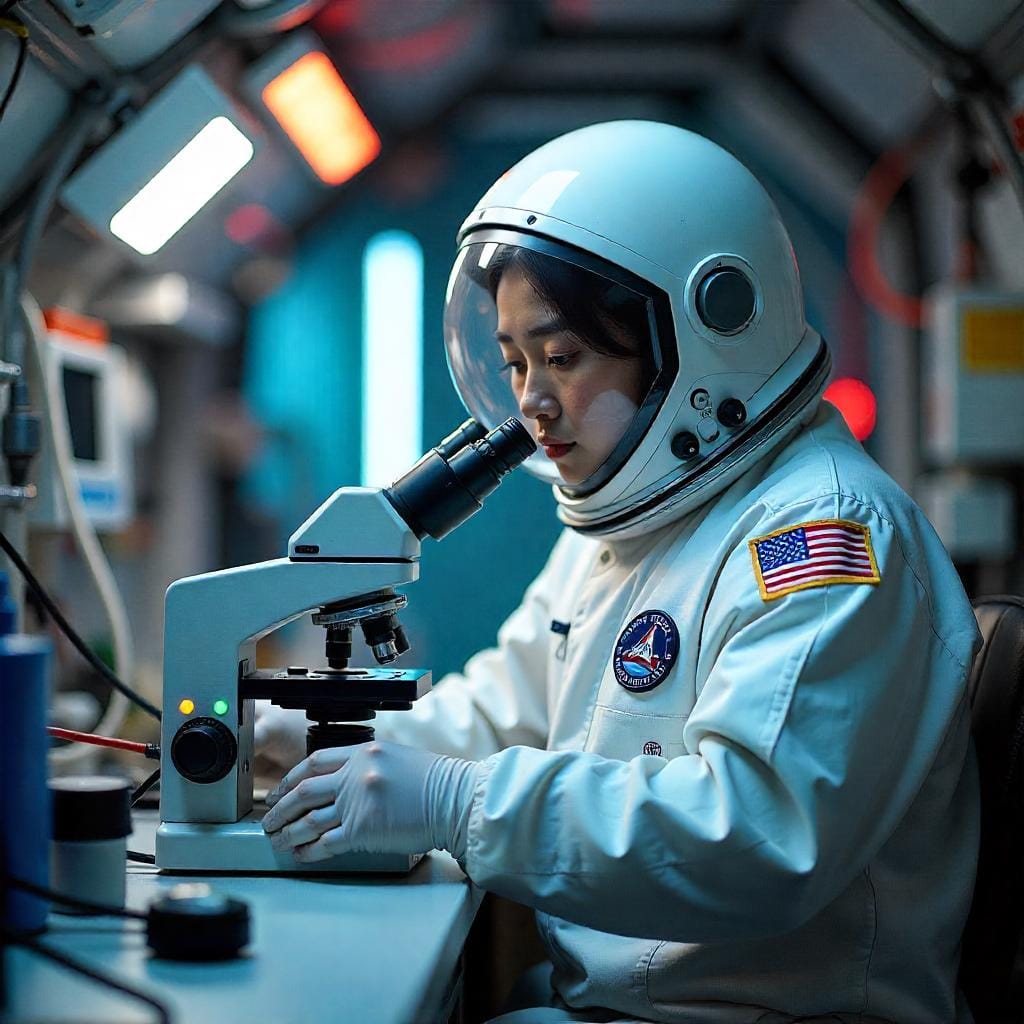Zero Gravity, Maximum Discovery: How Space Could Revolutionize Cancer Treatment
Cancer researchers are literally reaching for the stars, and the results are proving that space might hold the key to unlocking breakthrough treatments for one of humanity's deadliest diseases. As pharmaceutical companies and space agencies collaborate on orbiting laboratories, we're witnessing the birth of an entirely new frontier in oncology.
The Science Behind Space-Based Cancer Research
In the unique environment of space, cancer cells behave differently than they do on Earth. The microgravity conditions aboard the International Space Station (ISS) create a three-dimensional growth environment that more closely mimics how tumors develop in the human body. Unlike traditional laboratory cultures grown in flat petri dishes, space-grown cancer cells form spherical clusters called spheroids, providing researchers with unprecedented insights into tumor behavior.
Dr. Alshakim Nelson, a researcher from the University of Washington whose experiments have flown to the ISS, explains that these 3D models allow scientists to observe how cancer cells interact, communicate, and respond to treatments in ways impossible to replicate on Earth. The results have been remarkable: cancer cells in space often become more aggressive, revealing vulnerabilities that ground-based research might miss.

Pharmaceutical Giants Take Flight
Major pharmaceutical companies are investing heavily in space-based research. Merck has conducted multiple experiments on the ISS studying cancer immunotherapy, while companies like LambdaVision are developing treatments for retinal diseases using the unique properties of microgravity manufacturing.
One of the most promising areas involves tissue chips – miniature models of human organs that can be used to test drug effectiveness without human trials. NASA's Tissue Chips in Space initiative has already yielded valuable data about how cancer treatments affect healthy tissue, potentially reducing the harmful side effects that plague current therapies.
Manufacturing Medicines Among the Stars
Beyond research, space offers unique manufacturing opportunities. The absence of gravity allows for the creation of more uniform protein crystals, which could lead to more effective cancer drugs. Companies like Varda Space Industries are developing automated manufacturing platforms that could produce pharmaceuticals in orbit and return them to Earth.
The microgravity environment also enables the production of fiber optic cables with fewer impurities – technology that could improve surgical precision in cancer operations and enhance diagnostic imaging capabilities.
Current Missions and Future Possibilities
The ISS National Laboratory has already hosted over 50 investigations related to cancer and other diseases. Recent missions have included studies on:
- Tumor spheroids: Examining how cancer cells grow and respond to treatments in 3D environments
- Protein crystallization: Creating more effective drug compounds with improved purity
- Stem cell research: Understanding how healthy cells might better fight cancer
- Drug delivery systems: Developing more targeted therapies with fewer side effects
Looking ahead, private space stations from companies like Axiom Space and Blue Origin promise even more sophisticated research capabilities, with dedicated laboratory modules designed specifically for pharmaceutical research.

Challenges and Considerations
Despite the promise, space-based medical research faces significant hurdles. The cost of sending experiments to space remains high, though it's dropping rapidly as commercial spaceflight becomes more accessible. Each kilogram sent to the ISS currently costs approximately $20,000, making careful experiment selection crucial.
Additionally, the harsh space environment poses challenges for sensitive biological samples, requiring specialized equipment and protocols to ensure experiment integrity.
The Treatment Revolution on the Horizon
As technology advances, researchers envision space-based treatment facilities where patients might one day receive therapies impossible to deliver on Earth. While still decades away, concepts include:
- Radiation therapy using natural cosmic radiation in controlled doses
- Manufacturing personalized cancer treatments in space-based bioreactors
- Long-duration research missions studying cancer progression in microgravity
A New Era of Medical Discovery
Space-based cancer research represents more than just scientific curiosity – it's a paradigm shift in how we approach one of medicine's greatest challenges. As commercial space access expands and costs decrease, the boundary between Earth-based and space-based medical research will continue to blur.
The unique environment of space offers researchers tools and perspectives unavailable anywhere else, promising breakthroughs that could benefit millions of cancer patients worldwide. While we may not be treating cancer in space stations tomorrow, the research happening in orbit today is laying the groundwork for revolutionary treatments that will transform cancer care for generations to come.
The Microgravity Advantage: Why Space Changes Everything
On Earth, gravity constantly pulls on our cells, influencing how they grow, divide, and interact. But in the microgravity environment of space, these constraints disappear, revealing cellular behaviors that remain hidden under terrestrial conditions. Cancer cells, it turns out, behave very differently when freed from gravity's influence.
Recent experiments aboard the International Space Station (ISS) have shown that cancer cells grown in microgravity form three-dimensional clusters that more closely resemble how tumors actually develop in the human body. These "organoids" provide researchers with unprecedented insights into tumor formation, metastasis, and drug resistance—discoveries that simply aren't possible in traditional laboratory settings on Earth.
Breakthrough Discoveries Above the Clouds
Tissue Chips in Space
NASA's Tissue Chips in Space initiative has already yielded groundbreaking results. These miniature models of human organs, when studied in microgravity, reveal how cancer spreads and responds to treatments with remarkable accuracy. In 2019, experiments with lung tissue chips showed that cancer cells in space developed drug resistance patterns similar to those seen in advanced-stage patients—something that had been difficult to replicate in Earth-based studies.
Protein Crystal Growth
The microgravity environment also allows for the growth of larger, more perfect protein crystals—a crucial advantage for understanding the molecular structure of cancer-related proteins. These higher-quality crystals enable scientists to design more targeted and effective drugs. The pharmaceutical company Merck has already used space-grown crystals to improve the formulation of Keytruda, a leading cancer immunotherapy drug.
Real Results: From Lab to Life
The tangible benefits of space-based cancer research are already reaching patients. Data from the Center for the Advancement of Science in Space shows that pharmaceutical companies have conducted over 50 investigations on the ISS, many focused on cancer therapeutics. These studies have led to improved drug formulations, better understanding of drug delivery mechanisms, and new approaches to combination therapies.
One striking example involves research on cancer stem cells—the resilient cells that often survive traditional treatments and cause cancer to return. In microgravity, these cells behave more like they do in actual tumors, making them easier to study and potentially target with new therapies.
The Treatment Frontier: Space-Based Therapy
Looking ahead, some researchers envision space not just as a place to study cancer, but as a venue for treatment itself. The unique conditions of microgravity could potentially enhance certain therapeutic approaches:
- Enhanced drug manufacturing: Zero gravity allows for the production of more uniform drug particles and better mixing of complex pharmaceutical compounds
- Improved cellular therapies: CAR-T cell therapies, which modify a patient's immune cells to fight cancer, could be enhanced in space where cells grow and modify differently
- Reduced side effects: Some treatments might be more effective with fewer adverse effects when administered in microgravity
Challenges and Timeline
Despite the promise, significant hurdles remain. The cost of space-based research is still prohibitive for routine studies, though companies like SpaceX are driving costs down. Currently, sending experiments to the ISS costs approximately $20,000 per kilogram, though this figure continues to decrease with advancing technology.
Safety concerns also persist. Any space-based treatment would require extensive testing and likely wouldn't be available for widespread use for at least 15-20 years. However, the knowledge gained from space-based research is already accelerating Earth-based cancer treatments today.
The Final Frontier Meets the Fight for Life
As we stand on the brink of a new era in cancer research, space offers us something invaluable: a new perspective. By literally rising above our earthbound limitations, we're gaining insights that could transform how we understand and treat cancer. While space-based treatments may still be years away, the research happening 400 kilometers above our heads is already changing lives down here on Earth.
The next time you look up at the night sky, remember that among those distant points of light, scientists are working tirelessly in humanity's most ambitious laboratory, fighting our oldest battle against disease with tools as vast as the cosmos itself.
Target Audience: Healthcare professionals, medical researchers, science enthusiasts, biotech investors, patients and families affected by cancer, space industry professionals, science journalists.
